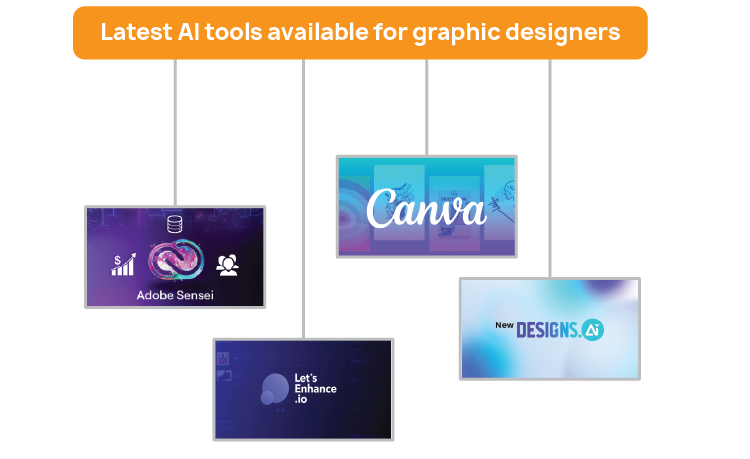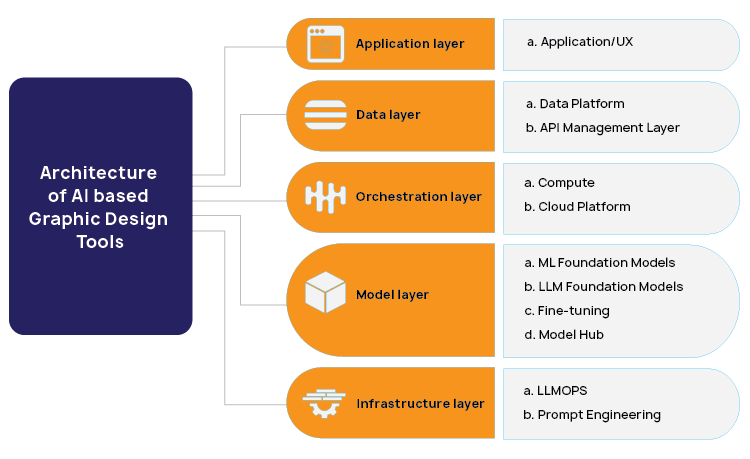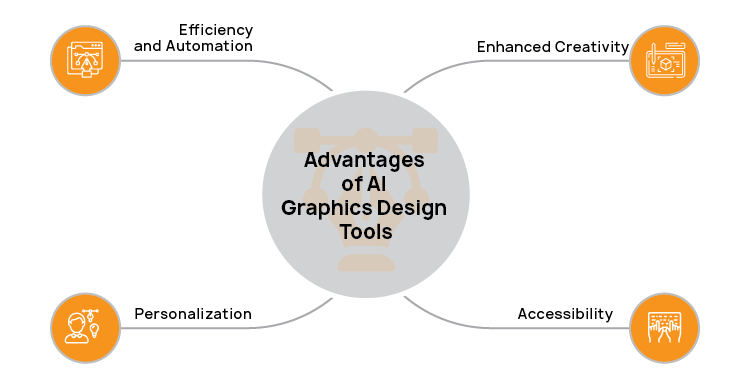


Dhruv Patel
5 Minutes read
The Impact of AI Graphic Design Tools on Modern Creativity
The landscape of graphic design is rapidly evolving, with artificial intelligence tools playing an increasingly significant role. This blog post explores the current impact of AI graphics design tools, examining whether they represent genuine value or simply fleeting buzz.
Artificial intelligence (AI) is making its mark on the graphic design industry through AI-powered design tools, which are changing the graphic design landscape. These tools have the potential to transform the way designers work, but do they truly bring value to the design process or simply generate hype? This blog post explores the impact of AI on graphic design work, exploring both the benefits and potential downsides.
The Rise of AI in Graphic Design
AI graphic design tools utilize algorithms to generate designs, layouts, and visual elements. These tools can automate repetitive tasks, offer design suggestions, and even create unique visuals based on specific input. The rise of AI in graphic design is driven by its potential to increase efficiency, reduce costs, and open up new creative possibilities.
AI graphic design tools are revolutionizing the graphic design industry by utilizing advanced algorithms and machine learning capabilities to automate a wide array of tasks that were traditionally performed manually by designers. These tasks include generating design layouts, suggesting color palettes, selecting typography, and even creating entire visual compositions. By automating these repetitive and time-consuming tasks, AI graphic design tools significantly increase the efficiency of designers, allowing them to focus on higher-level creative aspects of their work.
Furthermore, AI graphic design tools can analyze vast amounts of data and user preferences to provide personalized design recommendations and insights, leading to more effective and impactful designs. This data-driven approach also helps to reduce the costs associated with graphic design, as it minimizes the need for extensive revisions and redesigns.
Overall, AI graphic design tools are not only streamlining the design process but also democratizing graphic design by making it more accessible and affordable for businesses and individuals alike. As these tools continue to evolve and become more sophisticated, they are poised to unlock new creative possibilities and reshape the graphic design landscape in the years to come.
The Evolution of AI Tools in Graphic Design and Visualization
The landscape of graphic design is rapidly evolving, and at the forefront of this transformation are AI-powered tools. These tools are not just a passing trend; they represent a significant shift in how designers work, offering new possibilities for creativity, efficiency, and accessibility. From automating mundane tasks to generating innovative design concepts, AI is becoming an increasingly integral part of the graphic design process. This exploration delves into the realm of AI tools available for graphic designers, examining their capabilities, benefits, and how they’re reshaping the industry.
Here are some examples of AI tools available for graphic designers:
- Adobe Sensei: Integrated into Adobe Creative Cloud applications like Photoshop and Illustrator, Sensei provides features like automatic background removal, image upscaling, and intelligent object selection.
- Canva: This online design platform uses AI to offer design suggestions, layout assistance, and image recommendations based on user input.
- Designs.ai: This platform provides AI-powered tools for logo creation, video generation, and social media post design.
- Let’s Enhance: This AI-powered tool specializes in enhancing and upscaling images, improving resolution and detail.

The Architecture of AI-based graphic design tools
AI-based graphic design tools are built on a layered architecture that combines intuitive user interfaces with powerful AI engines. The front-end allows users to create and edit designs easily, while the AI engine—using models like GPT, DALL·E, or Stable Diffusion—generates visuals, suggests layouts, colors, and fonts based on user prompts. The application logic handles communication between the UI and AI, manages data flow, and processes real-time edits. Assets are stored securely in cloud-based storage, and real-time collaboration is enabled through technologies like WebSockets. A feedback system helps personalize user experiences by learning from interactions. Together, these components streamline the design process, making it faster, smarter, and more creative.

Advantages of AI Graphics Design Tools
Artificial intelligence is no longer a futuristic concept but a present reality in graphic design. We’ll delve into how AI tools are reshaping workflows, creativity, and the overall industry, and discuss the actual value they bring.
- Efficiency and Automation: AI can automate mundane and time-consuming tasks, such as image resizing, color correction, and background removal. This allows designers to focus on more strategic and creative aspects of their work.
- Enhanced Creativity: AI algorithms can generate a vast array of design ideas and variations, inspiring designers and pushing them beyond their usual creative boundaries. These tools can also help designers explore new styles and aesthetics.
- Personalization: AI can analyze user data and preferences to create personalized designs that resonate with specific target audiences. This can lead to more effective and engaging visual communication.
- Accessibility: AI-powered design tools can make graphic design more accessible to individuals without formal training or extensive experience.

Potential Drawbacks of AI Graphics Design Tools
In the realm of graphic design, AI tools are sparking both excitement and debate. Join us as we investigate the real-world effects of these technologies, and determine if they are truly transforming the field or just generating hype.
- Job Displacement: Concerns exist that AI could replace human graphic designers, particularly for tasks that are easily automated.
- Homogenization of Design: Overreliance on AI-generated designs could lead to a lack of originality and a homogenization of visual styles.
- Ethical Concerns: Issues surrounding copyright, ownership, and the potential for AI to generate offensive or inappropriate content need to be addressed.
- The “Black Box” Problem: The inner workings of AI algorithms can be opaque, making it difficult to understand how designs are generated and potentially leading to unintended biases.
The Future of AI and Graphic Design Tools
AI tools are rapidly becoming indispensable in the graphic design industry. The future of design lies in the collaboration between human designers and AI, where the automation and idea generation capabilities of AI are combined with the creativity, emotional intelligence, and critical thinking of human designers.
Designers of the future will need to be proficient in using AI tools, while simultaneously honing their critical thinking, communication, and problem-solving skills. This will lead to the emergence of hybrid professionals who can leverage AI to not only enhance their artistic talent but also to augment it with technical expertise, ultimately boosting their overall creativity and efficiency. AI can automate repetitive tasks, freeing up designers to focus on higher-level creative work. It can also generate a vast array of design ideas, providing designers with a starting point for their creative process. By working in tandem with AI, designers can push the boundaries of creativity and innovation, leading to new and exciting design solutions.
Furthermore, AI can assist designers in personalizing designs at scale, analyzing user data to create designs that are tailored to individual preferences. This level of personalization was previously unattainable, but with AI, it is becoming increasingly feasible. AI can also help designers stay ahead of the curve by identifying emerging trends and predicting future design directions. By embracing AI and continuously learning new skills, designers can future-proof their careers and remain competitive in the ever-evolving design landscape.
Conclusion
AI graphics design tools are not merely creating a buzz; they are genuinely impacting the graphic design work in profound ways. While there are legitimate concerns about the potential drawbacks, the advantages of AI in terms of efficiency, creativity, personalization, and accessibility cannot be ignored. By embracing AI as a tool and harnessing its power responsibly, graphic designers can unlock new levels of creativity and productivity. As with any technological advancement, the key lies in finding the right balance between human ingenuity and artificial intelligence.
ACL Digital, an ALTEN Group company, helps organizations succeed in the AI era. We offer AI and data-driven solutions across the technology stack. Partner with us for your digital transformation.




